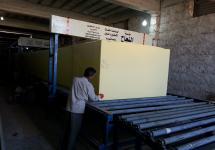Today the market offers many products. Including monuments that are installed on the graves of the deceased. Of course, at all times, marble or granite slabs and tombstones have been especially popular and valuable. But, as you know, such products are far from cheap. Concrete products have become an excellent alternative to expensive marble and granite monuments. They cost an order of magnitude cheaper and look quite presentable. And if you really want to, you can make a concrete monument with your own hands.
There are many advantages to monuments made of concrete. The most significant of them is, of course, the affordable cost. In addition, concrete products do not require any special care. They are easy to make and there are no difficulties in installation. The concrete monument will stand on the grave for decades.
Preparing for work
So, in order to make a monument or tombstone with your own hands, you should first make sure that you have everything you need at hand - tools, materials. It is also important to know the basic proportions for mixing concrete. Particular attention should be paid to the containers in which the monument will be cast.
Tools
The key point of the technical line is the vibrating table for moldings. Necessary to evenly compact the solution. It is on this table that during the production process containers will be installed into which the liquid source will be poured. Next, the tabletop will make movements, they will help compact the containers. As a result, the products are strong, high quality, and durable.
! A table is an indispensable machine tool for manual labor. Therefore, you will need to purchase it for production in any case. You will have to spend from 50,000 rubles.
 One of the necessary tools is a vibrating sieve.
One of the necessary tools is a vibrating sieve. Production cannot be done without a vibrating sieve. It is needed in case the purchased cement turns out to be of poor quality (sometimes it may contain foreign objects, pieces, pieces of paper, and so on). Under no circumstances should such impurities be allowed to enter the solution. Therefore, the cement should be sifted before mixing. Otherwise, the finished product may be unsuitable for use and will be written off as defective. By the way, you can replace the vibrating sieve with a manual device, but be prepared for the fact that sifting in this case will take much longer, which means it is not economically viable. The price of a vibrating sieve is from 10,000 rubles.
Concrete mixer or mixer. Also a necessary thing. Of course, you can knead the solution yourself, with your hands. But there is no guarantee that the solution will be homogeneous. A concrete mixer will allow you to prepare cement efficiently and, most importantly, quickly. Pay attention to the power of the unit, choose 130-165 hp. The price ranges from 11-16,000 rubles.
Concrete molds
When making concrete monuments, you can’t do without molds. If you are planning to make a simple monument, without intricate lines, an ordinary rectangular mold will do, which is quite possible to make yourself. The most important condition is that the container must have clear, even corners, the surface must be absolutely flat, there must be no chips, cracks, or other defects on it, otherwise all this will be reflected in the monument.
If desired, you can make patterned monuments. Containers for their production are sold in specialized stores or workshops that sell components for the production of monuments.
 In the mass production of monuments, there must be at least 10 template forms (and this is only at the initial stage of production) - the client should always have a choice. The uniform costs approximately 10-20,000 rubles. The materials from which the containers are made are polystyrene, PVC, ABS, fiberglass.
In the mass production of monuments, there must be at least 10 template forms (and this is only at the initial stage of production) - the client should always have a choice. The uniform costs approximately 10-20,000 rubles. The materials from which the containers are made are polystyrene, PVC, ABS, fiberglass.
The thickness of the container walls should not be more than 3 mm. The forms are lightweight and easy to transport, stack and store. Fiberglass molds are especially popular - they can be easily restored if damage suddenly occurs: scratches and cuts can be smoothed out with sandpaper. In addition, such containers require additional formwork and hold their shape perfectly.
Reinforcing elements
It is also impossible to do without reinforcing elements in the process of creating monuments. They are necessary to give strength to the product and durability of the final structure. As a rule, reinforcement is used whose thickness is at least 10-12 mm. A metal circle will also work. The dimensions of such elements directly depend on how much the monument weighs and on its configuration, therefore they are calculated individually for each specific case.
Cement
To produce monuments you will need cement, and of very high quality. It is best to use M500 grade concrete without additives (please note that the bag is marked D0). Don’t forget that cement will determine how durable and high-quality your product will be.
 Marble chips can be used as filler.
Marble chips can be used as filler. You can use fillers, for example, marble chips will do. However, it is not cheap. Therefore, many manufacturers prefer concrete dyes: they are added to the solution completely or to a part of it that will be used for exterior finishing.
It is a significant component; its presence in concrete makes the mixture more plastic, and it is easier to remove air masses from it, which is very important, especially if you do not have a vibrating table and compaction is done manually.
IMPORTANT! Choose only for the mixture, with it the material will be much stronger. Before adding sand, be sure to rinse it: pour it into a container, fill it with water, and stir. The sand will settle to the bottom. And all the garbage and impurities will float up. After this, all that remains is to drain the dirty water. The procedure is repeated two to three times.
The working process
Monuments are affected by many unfavorable factors. To extend the service life of the slab, to make it durable and of high quality, it is imperative to adhere to the technological process during manufacturing.
Preparing the solution
When preparing the solution, it is important to maintain the correct proportions. As a rule, the proportions are 70-72 kg. So, you will need:
- Cement. Brand 500, 22-24 kg.
- Granite screening of fraction 0-5 mm, 50-52 kg.
- River sand, 10 kg.
- Plasticizer, approximately 250 g.
- Water. Remember: the more it is, the longer the monument will dry, and pulling it out will be difficult. Drying will take up to 3 days or more. If you add too little water, holes may appear on the surface of the monument.
First of all, sand and cement are mixed. Next, you should dilute the plasticizer and dye in water (the consistency should resemble thick sour cream).
We give the appearance of a slab

conclusions
In order for the monument to be strong, high-quality and durable, you need to try and put maximum effort into it, and approach the production with all responsibility. This is the only way the result will be good. Manufacturing requires certain equipment, and it is also necessary to adhere to the technological process.


